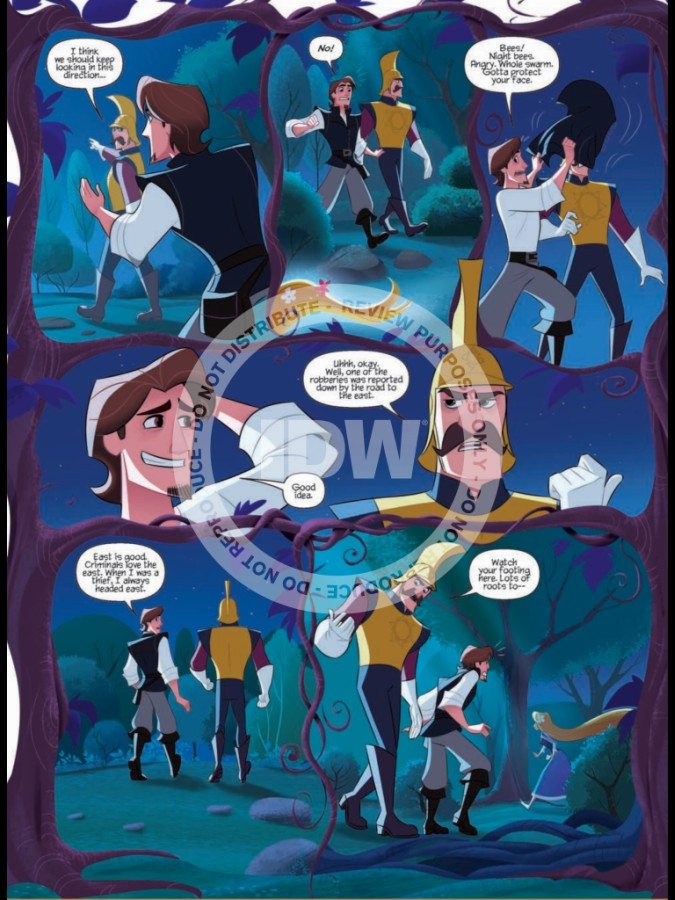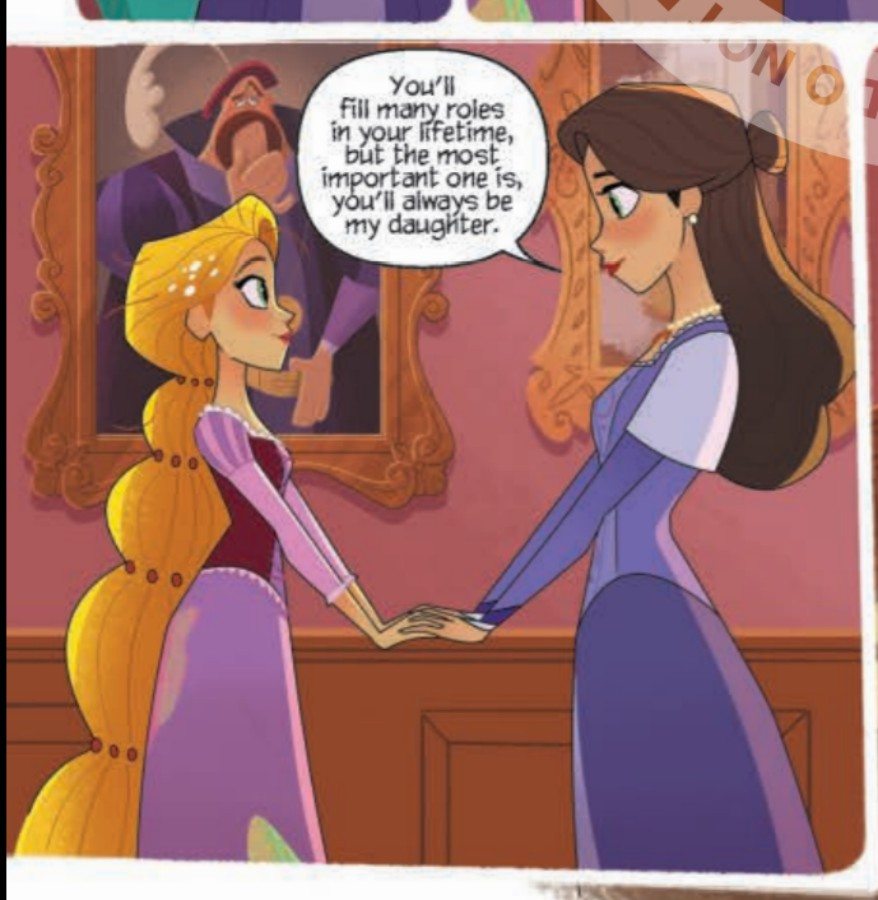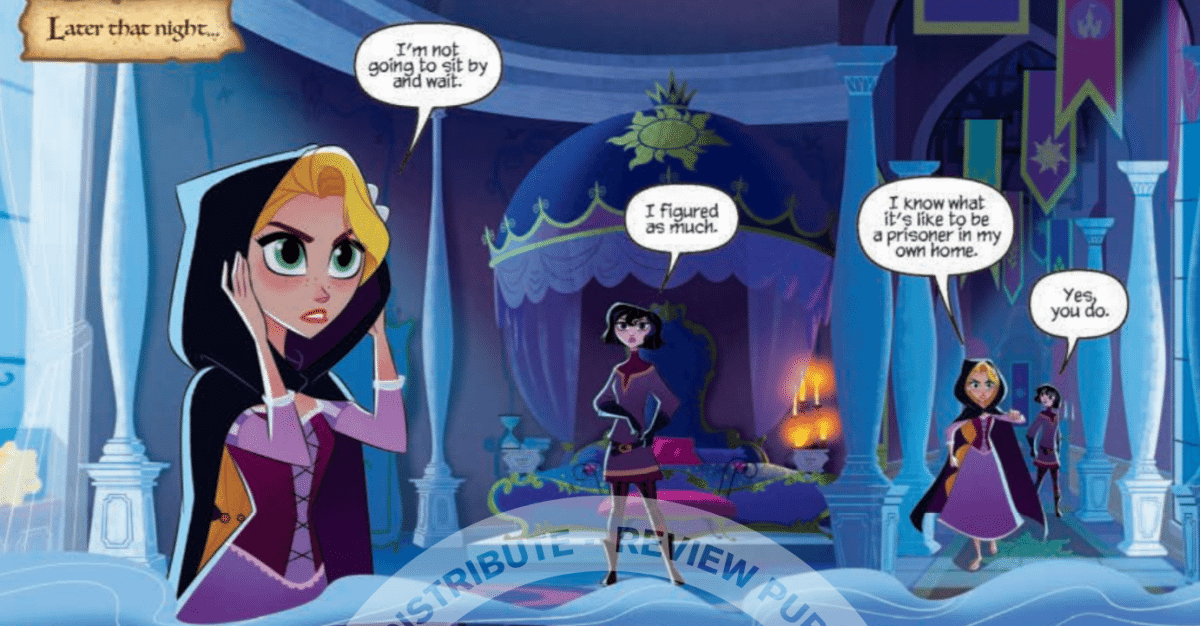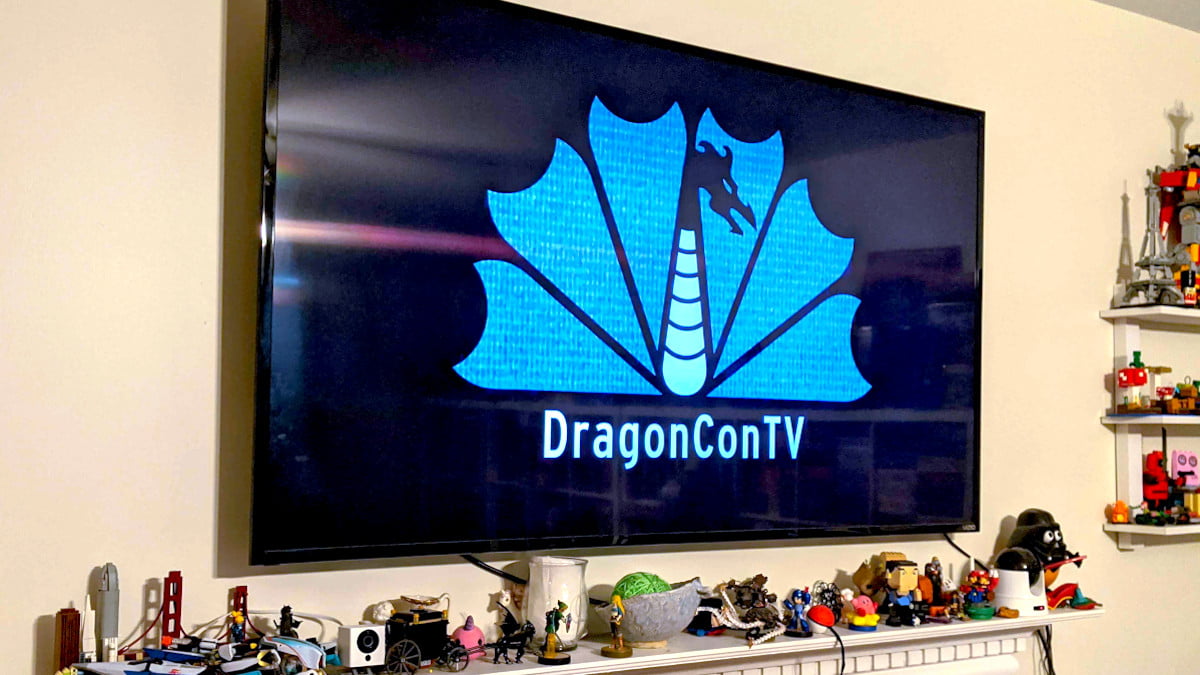
A Tangled comic? Sign me up. Or so I originally thought.
Let me explain.
My kids spent a summer watching Tangled. While the Rapunzel retelling never hit Frozen status in our household – we only watched it once or twice a day, instead of four or five – the story of a girl escaping an oppressive mother-figure to find her own identity was well loved.
My daughters loved Rapunzel’s magic hair, her lizard friend, and the idea of being a lost princess. I loved the way the romance between Rapunzel and Flynn took a backseat to Rapunzel’s exploration of her identity. Mother Gothel’s emotionally abusive behavior sparked a lot of important conversations about how people should and should not treat each other.
So what’s in Disney: Tangled: The Series #1?
Story A: “Guarding Against Adventure”
- Writer: Scott Peterson
- Art: Diogo Saito, Rosa La Barbera
- Colors: Vita Efremova, Ekaterina Myshalova
Story B: “Occupation Princess”
- Writer: Scott Peterson
- Art: Roberto Di Salvo, Rosa La Barbera
- Colors: Vita Efremova, Ekaterina Myshalova
Sounds good, yes? As I read the first issue, however, I realized that I’d missed two very important words in the comic’s title. Tangled: The Series.
This book is a tie-in from the currently running show on Disney XD. I, in fact, had not heard of a Tangled show because we don’t have Disney XD in our house.
This still shouldn’t have been a problem. Tie-in comics are often related to shows, but they don’t usually require an extensive knowledge of the show to be read and understood. While there were a lot of things about the DuckTales tie-in comic that frustrated me, one thing the comic did very well was to be approachable for someone not currently watching the show.
Tangled: The Series, unfortunately, is not approachable in that way.

Confusion Between Tangled: The Series and Tangled the Movie
If you’ve seen the movie, you know that there are several major changes that occur during the climax and resolution of the story. Rapunzel’s hair is cut off, changing from a super strong, superlatively long blonde rope with magic powers into a cute brown choppy bob that is perfectly Instagram-ready. Flynn reveals his real name – Eugene – to Rapunzel. The loss of Mother Gothel’s magical anti-aging skin care regime causes her to throw herself out of Rapunzel’s tower, removing the physical specter that prevented Rapunzel from being truly free.
In the comic, the most major of these changes – Rapunzel’s hair – has been reversed. Her hair is once again long, blonde, and vaguely prehensile. It is often shown in the fancy braid from the second half of the movie so that it is once again manageable (except when it’s let down for the purposes of action and/or adventure).

On one hand, I get it.
The movie is eight years old at this point, and all of the merchandise for Tangled has involved Rapunzel’s incredible blonde hair. It’s the genesis of the story. Cutting it, and the tether to her imprisonment, is also the climax of that story. I’m told the show offers a rationale for this, but the fact that the comic didn’t explain it – even in a quick set-up paragraph at the beginning of the issue or throwaway line – immediately put my teeth on edge. Not only is it bad craftsmanship, my kids still watch the movie from time to time; they’re detailed oriented enough that they would be upset by a discrepancy that was easy to fix.
That said, some changes from the movie I was perfectly fine with. The art in Tangled: The Series #1 matches the TV show, taking a pastel fairy tale style like Rapunzel’s tower paintings. These stylistic changes, a consequence of the change from CGI to ToonBoom animation, transfer well, showing something new and beautiful without abandoning the iconography established in the movie. For tie-in comics for kids, especially younger ones, this is necessary; it is also, of course, helpful for adults.
Tangled: An Issue With Design
The panel design in Tangled, however, is maddening. The gimmick to this series is its stylized layouts. This is, at times, beautiful and atmospheric. But because it’s used on every page, it quickly loses its impact. I don’t need gridded panels to read a comic – the brilliant layouts of George Pérez, one of my favorite comic book artists, is proof of that – but this is just hard to read. For every one page with an innovative layout that adds a beautiful dimension to the page and story itself, there are six that muddy the storytelling and just make it hard to read.


Original does not always mean good.
Tangled Moral Messages For Children
Much like the DuckTales series, also from IDW, issue #1 contains two stories; Story A is “Guarding Against Adventure,” while Story B is “Occupation Princess.” Let’s examine those storylines.
In the first story, the King bans travel outside of the village after dark due to bandit attacks. Rapunzel takes it upon herself to find the “ruffians” and lock them up so that her father will lift the ban. Eugene, meanwhile, is helping a castle guard try to track them down as well. He realizes Rapunzel is in the woods, against her father’s orders, and tries to keep the guard from noticing her. Hijinks ensue. Eventually, Rapunzel is instrumental in catching the thieves, and Eugene keeps her secret.
In “Occupation Princess,” meanwhile, Rapunzel wants to be something other than JUST a princess. She tries out various careers which she is hilariously bad at – including things that she was shown to be quite adept at in the movie – and eventually has a heart-to-heart with her mother. Her mother then informs Rapunzel that her greatest role is as her mother’s daughter.

I’m sorry for going back thirty years with this but my immediate reaction to this was “gag me with a spoon.” In the follow up to a story that focuses on how a child develops an identity apart from her abusive parent, returning her to that identity is infuriating. More than that, the practice of telling girls that their most important roles are within their families is both sexist and the literal opposite of the moral of the movie.
No matter how creative the panel layouts are, this is hack storytelling. It fills the page count required to sell a comic book with a series of subpar gags that lead to what is, technically speaking, an ending. I’m not asking for master class storytelling, but this isn’t even engaging schlock.
And Tangled Storytelling
The most noticeable failure of Tangled: The Series is that it fails to establish characters. Jim Shooter, former editor-in-chief of Marvel, was notorious for his stringent requirements for each comic that was published under his purview. You can groan if you like about the former EIC, but still acknowledge that he presided over a great deal of Marvel’s classic work. The first bullet point on his six item list of required story elements was this: characters must be introduced.

Without this simple but necessary piece of storytelling, the remaining elements – establish the situation, introduce conflict, build suspense, reach a climax, and reach a resolution – can’t be accomplished. By relying so heavily on the foreknowledge of the TV show, Tangled lets down its readers. Tie-ins are all well and good, but writers must acknowledge that tie-ins can also be a discovery method for the property, bringing new fans into the primary source.
I don’t require stories, either for myself or my kids, to have big sweeping plot arcs, carefully developed themes and messages, or intricate characterization that requires significant understanding of cultural background and historical context to comprehend. Those are nice, but they’re not required. What I do require, both for myself and my kids, is to to leave me with something I didn’t have before I started; that something can be simply a really good laugh.
I’m not ready to give up on Tangled: The Series; after all, I gave Star Trek:The Next Generation two seasons (and was eventually rewarded!). The art really is pretty, and the panel layouts that are cool are very, very cool. I want to see the stories firmed up, and the innovative panel layouts be confined to a few inspired pages in each issue. If they pull that off, this comic could be entertaining and a fun monthly pick.
Disclaimer: GeekMom received this comics issue as a review copy.





We watch Tangled, The Series, the cartoon in our house, and my kids both like it a lot. If you don’t watch the first couple of episodes though, then yeah, you’ll be somewhat lost on why/how she’s got her magic hair back and who some of the new characters are (*cough*Cassandra*cough*) since it’s a big change in direction from the end of the movie.
There is also an IDW tangled the series comic titled “Adventure is calling” which covers the story of “Before Ever After” about how Rapunzel’s hair regrows. You should read this one first.
Right – so this is a comic, based off of an animated series, based off of an old movie. Easy to get lost in, absolutely, but stick with me here – both the series, and the comic offshoot reviewed here, is drawn in Rapunzel’s art style which was seen in the film. The series is an actual story being told after they were married about what happened in the time frame between the film and their wedding short. Which also addresses why her hair is once again long.
Continuity. It works.